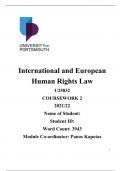International and European
Human Rights Law
U25832
COURSEWORK 2
2021/22
Name of Student:
Student ID:
Word Count: 3943
Module Co-ordinator: Panos Kapotas
1
, To the greatest extent feasible, the law should be clear, unambiguous, and predictable. A judge's
discretionary power should be used less frequently when it comes to enforcing legal rights and
responsibilities1. The law is a powerful tool in the fight against crime because of its certainty.
What makes law beautiful, accepted, and enforceable is its interpretation. The interpreter's job is
to make sure that the language used in the law represents the legislator's intent, as well as the
legislation's overall goal and the rule's appropriate meaning in the current legal and sociological
environment2. Justice in the truest sense can only be achieved through the combination of legal
clarity with interpretative flexibility3. Because of its unique concentration on working with
countries rather than people, this combination is particularly significant in international law.
Torture and other types of cruel, inhumane, or humiliating treatment are explicitly forbidden
under international human rights law, and no exceptions may be made to this prohibition under
any circumstances. There are, however, significant drawbacks to this strategy. The consensus is
that this is a matter of imputation rather than a basic legal need since the laws in question lack
absoluteness. It is not only possible but is officially enshrined in several of the most widely
recognized national human rights laws4. The inclusion of "cruel, inhuman, or degrading
treatment" in the same sections that prohibit torture does not imply that two separate forms of
destructive conduct must necessarily share the same status. As it turns out, this isn't true at all.
The argument that the prohibition is absolute in principle but flexible in reality is a fallacy that
should not be accepted. Finally, it is both immoral and illegal, as well as logically untenable, that
two conflicting declarations of an "absolute" right may both be equally absolute. Torture and
cruel, violent, or humiliating treatment are prohibited 'virtually' rather than as a matter of formal
law under human rights laws5. It applies in all except the most extreme circumstances, but not at
the expense of any rational explanation, exoneration, or mitigation. No one supports the concept
that officials should torture or abuse their subordinates on a regular basis, according to
recognized figures in the present discussion. The majority of people differ over whether such
behavior can ever be justified or forgiven, as well as the legal status of such behavior and the
right course of action for individuals who engage in it. It's unclear what the responses should be
after a mountain of study, owing to an instinctive moral decision between two incompatible sets
of values. Although many people are killed or maimed when a ticking bomb goes off, shielding
the perpetrator from any suffering that, had it been inflicted, could have prevented the
catastrophe is of far greater consequence 6. It's difficult to see how the right of the perpetrator to
be spared even the threat of suffering must always and typically overweigh the deaths and
injuries caused by the explosion because the ban against torture is based on the moral necessity
to eliminate all forms of intentionally inflicted unjust harm. This moral issue cannot be avoided
by international human rights legislation. The foundation for the absolute position of the rule
1
Kanstantsin Dzehtsiarou, 'European Consensus And The Evolutive Interpretation Of The European Convention On
Human Rights' (2011) 12 German Law Journal.
2
George Letsas, A Theory Of Interpretation Of The European Convention On Human Rights (Oxford University
Press 2010).
3
Fiona de Londras and Kanstantsin Dzehtsiarou, 'Managing Judicial Innovation In The European Court Of Human
Rights' (2015) 15 Human Rights Law Review.
4
Steven Greer, 'Is The Prohibition Against Torture, Cruel, Inhuman And Degrading Treatment Really ‘Absolute’ In
International Human Rights Law?' (2015) 15 Human Rights Law Review.
5
R. Bank, 'International Efforts To Combat Torture And Inhuman Treatment: Have The New Mechanisms
Improved Protection?' (1997) 8 European Journal of International Law.
6
Mork Lomell, 'Yuval Ginbar: Why Not Torture Terrorists? Moral, Practical, And Legal Aspects Of The Ticking
Bomb Justification For Torture' (2011) 28 Nordic Journal of Human Rights.
2




